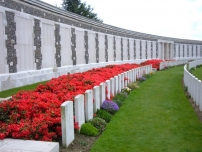| First Name: | Samuel Arthur | Last Name: | MOREMENT | |
|---|---|---|---|---|
| Date of Death: | 04/10/1917 | Lived/Born In: | Queen's Park | |
| Rank: | Private | Unit: | Middlesex3/10 | |
| Memorial Site: | Tyne Cot Memorial, Belgium | |||
Current Information:Age-31 84, Portnall Road, Queen's Park
Third Battle of Ypres This was a campaign fought between July and November 1917 and is often referred to as the Battle of Passchendaele, a village to the north-east of Ypres which was finally captured in November. It was an attempt by the British to break out of the Ypres salient and capture the higher ground to the south and the east from which the enemy had been able to dominate the salient. It began well but two important factors weighed against them. First was the weather. The summer of 1917 turned out to be one of the the wettest on record and soon the battlefield was reduced to a morass of mud which made progress very difficult, if not impossible in places. The second was the defensive arrangements of concrete blockhouses and machine gun posts providing inter-locking fire that the Germans had constructed and which were extremely difficult and costly to counter. For 4 months this epic struggle continued by the end of which the salient had been greatly expanded in size but the vital break out had not been achieved. The Battle of Broodseinde - 4th October, 1917 After the disappointing opening battles of the last day of July and the middle of August, when very little had been gained but at great cost in casualties, a new approach was adopted for the next offensives against the Gheluvelt plateau which began on 20th September with the Battle of the Menin Road, was continued on 26th September, when the Battle of Polygon Wood commenced, and was concluded on 4th October with the Battle of Broodseinde. The task was handed over to General Plumer, commander of the Second Army, a more cautious leader who, rather than try to drive as deep as possible into the German line, was an advocate of 'bite and hold' tactics with limited advances of no more than 1,500 yards, based on overwhelming firepower and exhaustive preparation. These new tactics, which were significantly aided by a period of warm, dry weather, worked well and September and early October saw a decisive phase of Third Ypres in which the British gained the upper hand. At the same time that Plumer’s Second Army were hammering away at the German defences on the Gheluvelt plateau, Fifth Army also attacked in the northern part of the Ypres salient and they too made gains. Both sides were planning an attack on 4th October and when the British bombardment began, it caught a number of German units out in the open preparing for their own attack. Zero hour was either 5.25am or 6am and at that time, Australian, New Zealand and British divisions moved into action behind a creeping artillery barrage. As at Menin Road Ridge and Polygon Wood, the British attack achieved its main objectives and then halted to dig in. The Germans lost heavily on 4th October and the battle was recorded as a “black day” in the official German history of the war. 3/10th Middlesex arrived in France in June 1917 and in July, after a period of trench instruction, joined 10 Brigade of 4th Division at Arras. They remained here until September when the 4th Division moved north to Ypres and the Battle of Passchendaele. The battalion’s first major engagement came on 4th October when 4th Division attacked on the left flank of Fifth Army towards Poelcappelle. 2nd Seaforth Highlanders led the attack of 10 Brigade with 3/10th Middlesex in support. Making their way across the Lauterbeek marsh, they came under machine-gun fire from the left which caused a temporary loss of direction, but parties from both battalions then moved on to their first objective, the far side of 19 metre Hill. However, this was a very exposed position and they were raked by machine-gun fire as they lay there, desperately digging in, trying to find some cover. In the middle of the afternoon German counter attacks came within 80 yards of their positions and with ammunition running out and despite the assistance of 1st Warwickshire, also of 10 Brigade, all units were forced to fall back to the western side of the hill where they consolidated what gains they had made. 3/10th Middlesex suffered many casualties in this their first real baptism of fire one of whom was Samuel Morement who was killed in action. |
||||
| « Back to Search Results | ||||
| If you think any of the information shown here is incorrect, Click Here to submit your amends and comments | ||||




